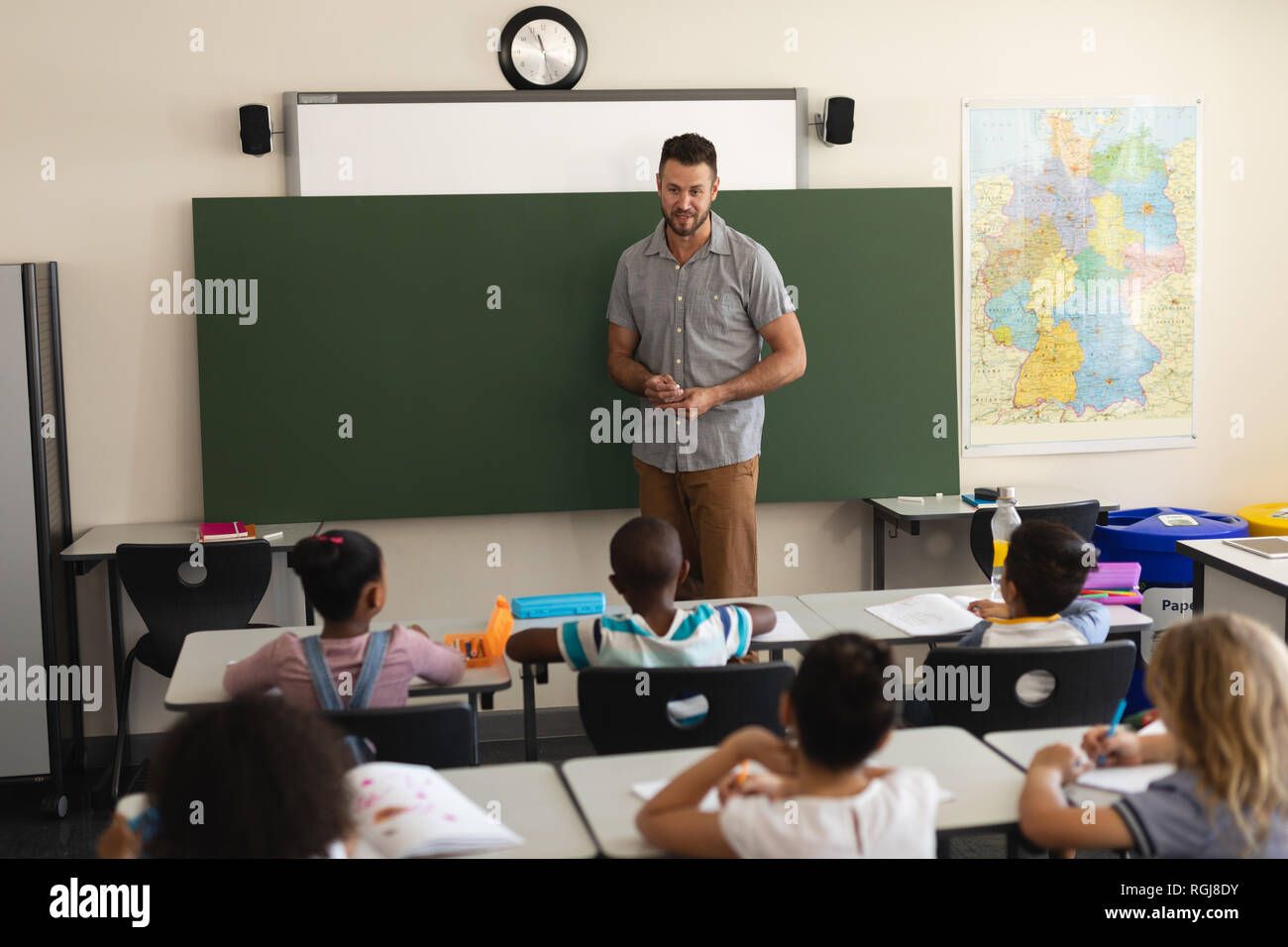Accelerate Learning with Primary Science Tuition Singapore for Young Minds
Accelerate Learning with Primary Science Tuition Singapore for Young Minds
Blog Article
A Comprehensive Overview to the Various Understanding Techniques in Primary Scientific Research Guideline
The exploration of varied discovering methods in main science guideline presents a chance for instructors to enhance pupil interaction and understanding significantly. By examining hands-on knowing techniques, inquiry-based approaches, and joint strategies, we can determine efficient techniques that accommodate different finding out designs. Additionally, the combination of modern technology and set apart instruction plays a crucial role in cultivating a comprehensive environment. The inquiry stays: how can these methods be successfully carried out in the classroom to optimize their impact? The solution depends on a closer assessment of each approach and its effects for teaching science.

Hands-On Knowing Techniques
Hands-on knowing methods play a crucial duty in key science direction, involving trainees in energetic exploration and trial and error. These methods permit students to connect directly with products and phenomena, promoting a much deeper understanding of clinical concepts. By utilizing manipulatives, designs, and real-life experiments, educators create an environment where pupils can observe, assume, and test their concepts.
Such strategies not only improve comprehension yet also cultivate vital thinking and problem-solving skills. When trainees participate in activities like constructing straightforward equipments, growing seeds, or carrying out chain reactions, they are urged to ask concerns and look for answers with their very own monitorings. This experiential method helps to debunk complicated clinical concepts, making them more available and relatable.
Moreover, hands-on knowing promotes collaboration among peers, as trainees typically operate in teams to carry out experiments or share searchings for. This team effort not just improves their learning experience however additionally creates vital social abilities. Eventually, integrating hands-on strategies in key science instruction promotes a lifelong love of learning and curiosity regarding the all-natural world, laying a strong foundation for future scholastic quests in scientific research and beyond.
Inquiry-Based Learning
Inquiry-based understanding is a training approach that urges pupils to ask inquiries, investigate phenomena, and create their own understanding of clinical concepts. This approach moves the emphasis from standard teacher-led instruction to a much more student-centered experience, where learners take the effort in their educational journey. By cultivating curiosity, inquiry-based knowing promotes much deeper involvement with the product, permitting trainees to check out subjects in a significant context.
In practice, this method typically includes hands-on experiments, observations, and important thinking activities that align closely with the clinical approach. Pupils are urged to formulate hypotheses, design examinations, and examine information, which grows important abilities such as analytical and problem-solving reasoning. The function of the instructor in this framework is to assist in expedition, guiding students through the query procedure while encouraging independent idea and partnership.
Additionally, inquiry-based understanding supports a feeling of possession over the learning process, encouraging pupils to go after knowledge proactively. This technique not just improves understanding of scientific ideas but additionally promotes a lifelong love for learning, furnishing pupils with the skills needed to browse an increasingly complicated globe.
Collaborative Knowing Approaches
Collective discovering techniques empower trainees to participate in meaningful communications with peers, fostering a common obligation for their academic results. In main science guideline, these strategies motivate students to interact to discover scientific principles, fix problems, and perform experiments (primary science tuition Singapore). By participating in group activities, pupils can leverage diverse point of views, enabling richer understanding and retention of clinical understanding
One trick aspect of collaborative discovering is the emphasis on communication abilities. Pupils need to articulate their thoughts, pay read more attention proactively to others, and discuss concepts, every one of which are important expertises in both real-world and academic contexts. This social interaction not just enhances their understanding of clinical principles however additionally advertises teamwork and problem resolution abilities.
Furthermore, collaborative understanding typically brings about raised motivation and interaction. When trainees see the value of their contributions within a group, they are more probable to take possession of their understanding journey. Teachers can promote this procedure by creating structured team tasks that align with curriculum objectives while giving support on efficient partnership techniques. On the whole, integrating collaborative learning techniques in primary scientific research instruction cultivates a dynamic understanding atmosphere that prepares students for future scholastic and social difficulties.
Technology Combination in Scientific Research
The integration of technology in main science instruction boosts discovering experiences by offering ingenious devices and sources that sustain different mentor techniques, including collaborative discovering - primary science tuition Singapore. Using electronic systems, simulations, and interactive applications allows pupils to engage deeply with scientific concepts, promoting an extra hands-on strategy to understanding
Digital labs, as an example, make it possible for students to carry out experiments safely and efficiently, promoting inquiry-based discovering. These tools can replicate real-world scientific circumstances, enabling trainees to picture intricate procedures that would be challenging to duplicate in a traditional class setting. In addition, technology fosters communication and collaboration among trainees, as they can share findings and collaborate on tasks via on the internet systems.
Furthermore, multimedia presentations and instructional videos can enrich lessons by dealing with varied understanding styles, making abstract concepts much more obtainable. Information analysis tools also equip trainees to gather and analyze clinical information, reinforcing vital believing abilities. On the whole, the strategic incorporation of technology in main science direction not just improves involvement yet additionally prepares pupils for a highly innovative culture, outfitting them with important skills for future scientific ventures.
Distinguished Instruction Techniques
Distinguished direction methods are necessary for resolving the varied needs of learners in primary scientific research education and learning. These approaches allow instructors to customize their mentor methods to accommodate varying capabilities, interests, and learning styles within the class. By employing separated direction, teachers can create an inclusive atmosphere that fosters engagement and enhances understanding of clinical principles.
One reliable approach is to make use of adaptable organizing, which allows trainees to collaborate with peers at similar skill levels or with varying viewpoints. This technique click to investigate urges peer understanding and promotes vital thinking. In addition, using options in tasks can equip trainees, allowing them to select tasks that reverberate with their passions while still meeting curricular objectives.
In addition, including tiered tasks is one more beneficial strategy. By designing jobs with varying degrees of complexity, teachers can ensure that all trainees are suitably challenged, no matter of their proficiency. Making use of formative evaluations to determine understanding more enables instructors to readjust their instructional techniques dynamically, making certain that each learner gets the assistance they need.
Ultimately, carrying out differentiated direction approaches in primary science education not just boosts pupil learning outcomes however additionally grows a passion for science, preparing students for future academic quests.

Conclusion
In summary, reliable main scientific research instruction demands a multifaceted approach that includes hands-on discovering, inquiry-based methods, and collective strategies. The combination of modern technology and separated direction additionally caters to varied knowing styles, fostering an atmosphere favorable to expedition and critical thinking.
The exploration of diverse discovering approaches in key science guideline offers an opportunity for teachers to enhance trainee click this link involvement and understanding considerably.Hands-on knowing methods play an essential function in main scientific research direction, engaging trainees in active exploration and testing.Inquiry-based discovering is a training technique that motivates trainees to ask concerns, examine phenomena, and construct their very own understanding of clinical principles.Collective knowing methods empower students to involve in purposeful communications with peers, promoting a shared responsibility for their instructional end results. Generally, integrating collective knowing approaches in key scientific research direction cultivates a vibrant discovering atmosphere that prepares trainees for future academic and social obstacles.
Report this page